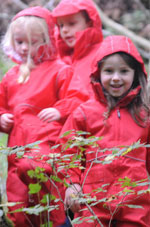The Teaching in Nature research project
Dr Greg Mannion and a team of researchers from the Faculty of Social Sciences (Education), were funded by Scottish Natural Heritage to use research to support the Teaching in Nature project. This work was a continuation of the on-going research on curriculum and learning in the Faculty (including environmental and science education, outdoor learning, and education about, in and for nature). The project built on previous work in this area (Mannion et al. 2007, see: Scottish Natural Heritage Report No. 225).
This project gave teachers the opportunity to assess a suitable natural area for its educational potential, choose or develop activities for their classes, and test them out. Practitioners from primary, secondary or pre-school sectors across a range of subject areas worked as teacher-researchers to inquire into some of the key research questions around outdoor education. 18 teachers worked in four groups to plan and execute class visits to discover more about the effects on learning of employing different pedagogies, purposes, and activities outdoors. 11 teachers' visits were researched in more depth and these visits are documented in this website. All outdoor areas were designated National Nature Reserves (or other local wild places such as area of Special Scientific Interest).
Group members were entirely free to try any approach they wish. Each group of teacher-researchers visited their site to conduct planning and to design their class visits. SNH staff members acted as guides and also advised on where to find local knowledge about the place – history, archaeology, economy, etc.. Funds were made available for cover for teachers while they engage in planning / attending workshops which supported the project.
The research methodology was a form of collaborative action inquiry. While the project was teacher-led, they also had access to expert help and advice about both their plans for outdoor education but also their work as teacher-researchers. The research project used workshops to convene the teacher-researchers with the educational researchers from the university and SNH staff to discuss their on-going action projects. Using a comparative case study approach and collaborative feedback mechanisms, the teachers and university staff engaged in research conversations around their experiences. The university staff and the teacher researchers collected a range of evidence types inclusive of teacher-generated work and student work, video and photographs of activities in class (before and after visits) and participant observation of the outdoor visits themselves. Together, they worked to analyse this evidence within focus groups and during the workshops to generate new qualitative understandings about teaching in nature. The project has generated some really useful knowledge about what approaches are likely to work in what contexts, how barriers to outdoor access and activity can be overcome, how strategies and planning can be undertaken with ease (even by 'novice outdoor' educators). The consequences for these new approaches, aims and purposes are explored within the context of the curriculum initiative Curriculum for Excellence.
The General Teaching Council of Scotland were advising and assisting with this project. Other consultancy came from Professor Pete Higgins and Juliet Robertson (Creative Star).


